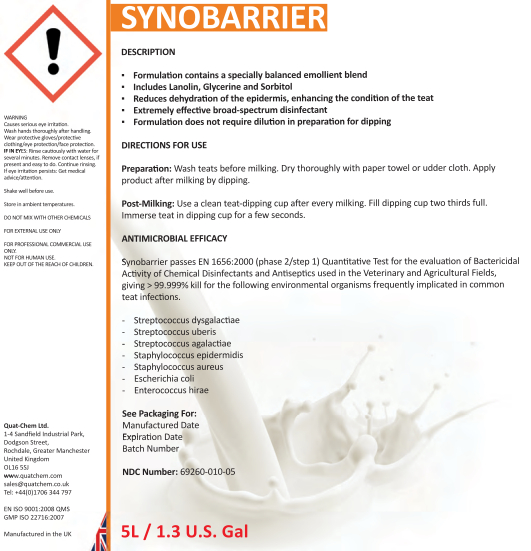Animal NDC 69260-010-25 Synobarrier
Teat Dip
Animal Product Information
Synobarrier Images
Synobarrier Animal Product Labeling Information
The product labeling information includes all published material associated to a drug. Product labeling documents include information like generic names, active ingredients, ingredient strength dosage, routes of administration, appearance, usage, warnings, inactive ingredients, etc.
Table of Contents
Synobarrier
WARNING
Causes serious eye irritation.
Wash hands thoroughly after handling.
Wear protective gloves/protective clothing/eye protection/face protection.
IF IN EYES: Rinse cautiously with water for several minutes. Remove contact lenses, if present and easy to do. Continue rinsing.
If eye irritation persists: Get medical advice/attention.
Shake well before use.
Store in ambient temperatures.
DO NOT MIX WITH OTHER CHEMICALS
FOR EXTERNAL USE ONLY
FOR PROFESSIONAL COMMERCIAL USE ONLY.
NOT FOR HUMAN USE.
KEEP OUT OF THE REACH OF CHILDREN
Quat-Chem Ltd.
1-4 Sandfield Industrial Park,
Dodgson Street,
Rochdale, Greater Manchester
United Kingdom
OL16 5SJ
www.quatchem.com
[email protected]
Tel: +44(0)1706 344 797
EN ISO 9001:2008 QMS
GMP ISO 22716:2007
Manufactured in the UK
DESCRIPTION
▪ Formulation contains a specially balanced emollient blend
▪ Includes Lanolin, Glycerine and Sorbitol
▪ Reduces dehydration of the epidermis, enhancing the condition of the teat
▪ Extremely effective broad-spectrum disinfectant
▪ Formulation does not require dilution in preparation for dipping
DIRDIRECTIONS FOR USE
Preparation: Wash teats before milking. Dry thoroughly with paper towel or udder cloth. Apply
product after milking by dipping.
Post-Milking: Use a clean teat-dipping cup after every milking. Fill dipping cup two thirds full.
Immerse teat in dipping cup for a few seconds.
ANTIMICROBIAL EFFICACY
Synobarrier passes EN 1656:2000 (phase 2/step 1) Quantitative Test for the evaluation of Bactericidal
Activity of Chemical Disinfectants and Antiseptics used in the Veterinary and Agricultural Fields,
giving > 99.999% kill for the following environmental organisms frequently implicated in common
teat infections.
- Streptococcus dysgalactiae
- Streptococcus uberis
- Streptococcus agalactiae
- Staphylococcus epidermidis
- Staphylococcus aureus
- Escherichia coli
- Enterococcus hirae
See Packaging For:
Manufactured Date
Expiration Date
Batch Number
NDC Number:
* The information on this page is for an ANIMAL PRODUCT, please review the complete disclaimer below.

